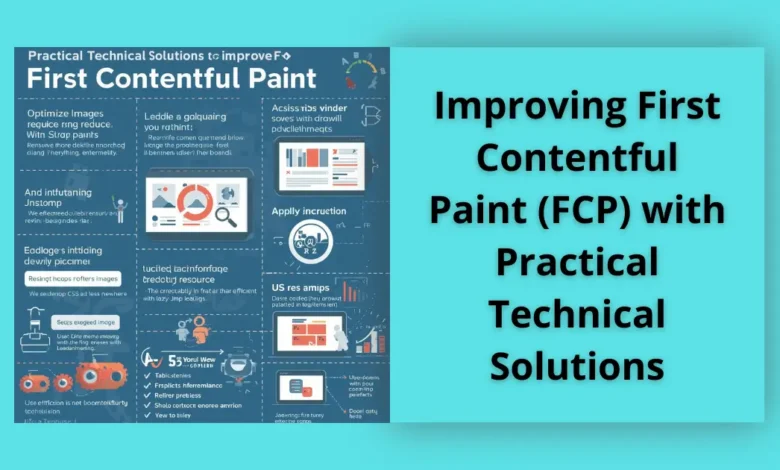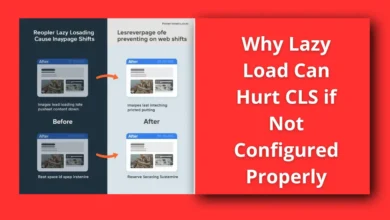Improving First Contentful Paint (FCP) with Practical Technical Solutions

Improving First Contentful Paint (FCP) with LiteSpeed Cache, image optimization, and viewport loading ensures faster rendering, better UX, and higher SEO rankings.
Improving First Contentful Paint (FCP) is one of the most critical steps in optimizing web performance. While many web developers focus on overall page speed, FCP specifically measures how quickly the first visual content appears on a user’s screen. This article explores practical technical solutions for developers and site owners, including LiteSpeed Cache settings, image optimization, and viewport-based loading, to achieve faster FCP scores for both mobile and desktop users.
table of contents
What is First Contentful Paint (FCP)?
First Contentful Paint (FCP) is a Core Web Vital metric that measures the time from when a user starts loading a page until any part of the page’s content is visible. This includes text, images, or other visible elements.
A fast FCP improves user perception of speed, encourages engagement, and boosts search engine rankings. Slow FCP, on the other hand, can increase bounce rates and negatively affect SEO.
Best way to write human-style content that ranks in 2025 algorithms
Key Factors Affecting FCP
- Render-Blocking CSS and JavaScript
- Large CSS files or scripts that block the main thread can delay the first paint.
- Server Response Time
- Slow server responses increase the time before the first byte reaches the browser.
- Image Optimization
- Uncompressed or oversized images can significantly delay rendering, especially above-the-fold visuals.
- Lazy Loading Misconfiguration
- Lazy loading all images, including above-the-fold, can inadvertently delay FCP.
- Third-Party Scripts
- Ads, analytics, and social widgets can block rendering if not loaded asynchronously.
Technical Solutions to Improve FCP
1. Server and Hosting Optimization
- Use LiteSpeed or High-Performance Hosting: LiteSpeed servers improve response time and reduce delays.
- Enable Page Caching: Using LiteSpeed Cache or similar solutions ensures the page is served instantly.
- Deploy a CDN (Content Delivery Network): Deliver assets closer to users to minimize latency.
2. Minimize Render-Blocking Resources
- Inline Critical CSS
- Only essential CSS for above-the-fold content should load immediately.
- Defer Non-Critical JavaScript
- Use
deferorasyncattributes to prevent scripts from blocking rendering.
- Use
- Remove Unused CSS and JS
- Reduce payload size and minimize blocking by removing unused styles or scripts.
Example: In LiteSpeed Cache:
- Navigate to Page Optimization → CSS Settings
- Enable Optimize CSS Delivery
- Inline critical CSS while deferring non-essential styles.
3. Image Optimization with LiteSpeed Cache
Images are often the largest contributors to FCP delays. To optimize:
- Compress Images Efficiently
- Use WebP or AVIF formats for smaller file sizes.
- Enable LiteSpeed Image Optimization for automated compression.
- Lazy Load Non-Critical Images
- Enable Lazy Load Images in LiteSpeed Cache.
- Exclude above-the-fold images from lazy load to prevent FCP delays.
- Use LQIP (Low-Quality Image Placeholder)
- Display a blurred low-resolution version immediately.
- LiteSpeed Cloud Generator can generate placeholders to avoid blank spaces.
- Set Explicit Width and Height
- Enable Add Missing Sizes in LiteSpeed Cache.
- This prevents layout shifts and ensures a stable first paint.
4. Prioritize Above-the-Fold Content
Above-the-fold content is what users see first, so it should load immediately.
- Viewport Images:
- Enable Viewport Images in LiteSpeed Cache to detect above-the-fold images.
- These images are excluded from lazy load and render instantly, improving FCP.
- Viewport Images Cron:
- Automatically processes new images for above-the-fold display using scheduled tasks, keeping FCP optimized without manual intervention.
5. Reduce Third-Party Script Impact
Third-party scripts can block rendering. Best practices:
- Load scripts asynchronously or defer them until after critical content.
- Limit the number of third-party scripts on the homepage or above-the-fold areas.
Example:
<script src="analytics.js" async></script>
<script src="chat-widget.js" defer></script>
6. Minification and Compression
- Minify HTML, CSS, and JS: Reduces file sizes and speeds up rendering.
- Enable GZIP or Brotli compression: Reduces data transfer time.
- Combine Files Where Possible: Fewer HTTP requests accelerate FCP.
In LiteSpeed Cache:
- Go to Page Optimization → JS/CSS Settings
- Enable Minify, Combine, and Load CSS/JS Asynchronously.
7. Measuring FCP Performance
Monitor improvements using:
- Google PageSpeed Insights → Measures FCP and Core Web Vitals.
- Lighthouse in Chrome DevTools → Provides actionable insights.
- Web Vitals Chrome Extension → Tracks live metrics for real users.
Check both mobile and desktop, as FCP can differ due to device performance and network conditions.
Best Practices Checklist
| Action | Recommended Setting | Tool/Method |
|---|---|---|
| Optimize images | WebP/AVIF + LQIP | LiteSpeed Cache Image Optimization |
| Above-the-fold content | Exclude from lazy load | Viewport Images |
| Critical CSS | Inline only for screen | LiteSpeed Optimize CSS Delivery |
| JavaScript | Defer or async | LiteSpeed Page Optimization |
| Compression | GZIP/Brotli | Server settings or LiteSpeed Cache |
| Caching | Page & Object Cache | LiteSpeed Cache / Redis |
| Third-party scripts | Async/Defer | Manual script adjustment |
Conclusion
Improving First Contentful Paint (FCP) is essential for fast, responsive websites. By optimizing server performance, compressing images, prioritizing above-the-fold content, and leveraging LiteSpeed Cache features such as Lazy Load, LQIP, Viewport Images, and Add Missing Sizes, developers can deliver a smooth, immediate visual experience. Faster FCP enhances Core Web Vitals, boosts SEO rankings, and creates a superior experience for users on both mobile and desktop devices.
FAQ
Q1: What is a good FCP score?
A: Ideally under 1.8 seconds; Google considers below 2 seconds as good.
Q2: How does LiteSpeed Cache help FCP?
A: By combining Lazy Load, Viewport Images, LQIP, Add Missing Sizes, and CSS/JS optimization, LiteSpeed ensures fast rendering of above-the-fold content.
Q3: Can above-the-fold images be lazy-loaded?
A: No. They must be excluded using Viewport Images to avoid delaying FCP.
Q4: Does server response affect FCP?
A: Yes, a slow server increases First Byte Time, which directly delays FCP.
Q5: Are third-party scripts important for FCP?
A: They can block rendering. Load asynchronously or defer to prevent delays.
اكتشاف المزيد من Feenanoor
اشترك للحصول على أحدث التدوينات المرسلة إلى بريدك الإلكتروني.





